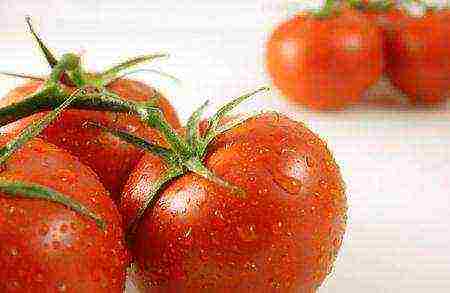Content
- 1 The best pear varieties for central Russia, the Moscow region and the Urals
- 2 Summer pear varieties
- 3 Winter
- 4 Late
- 5 Autumn
- 6 Pear for the Volga region and central Russia
- 7 Garden varieties for the Moscow region, description
- 8 August dew
- 9 Veles
- 10 Duchess Summer (Williams)
- 11 Clapp's Favorite
- 12 Muscovite
- 13 Olivier de Serre
- 14 Simply Maria
- 15 Features of cultivation in the Moscow region
- 16 Pear care in the suburbs
- 17 Groundbait to increase pear yield
- 18 ★ Rating of popular pear varieties
- 19 The best pear varieties according to production data
- 20 Answers to frequently asked questions
- 21 Gardeners' mistakes during cultivation
- 22 🎥 Video lesson from Bogdan Ribak "Review of the super variety Talgar beauty"
Not so long ago, the cultivation of pears was treated with caution. Unlike the apple tree, it was more whimsical, did not tolerate frost or sudden changes in temperature. Today, breeders have bred more than 200 different varieties, including frost-resistant ones, which can grow in all regions of Russia, including Siberia and the Urals. Considering that many varieties have not yet been fully tested by gardeners, we will tell you what are the best pear varieties for the Moscow region, the middle lane, the northern regions, and we will separately tell you about the varieties of different ripening periods.
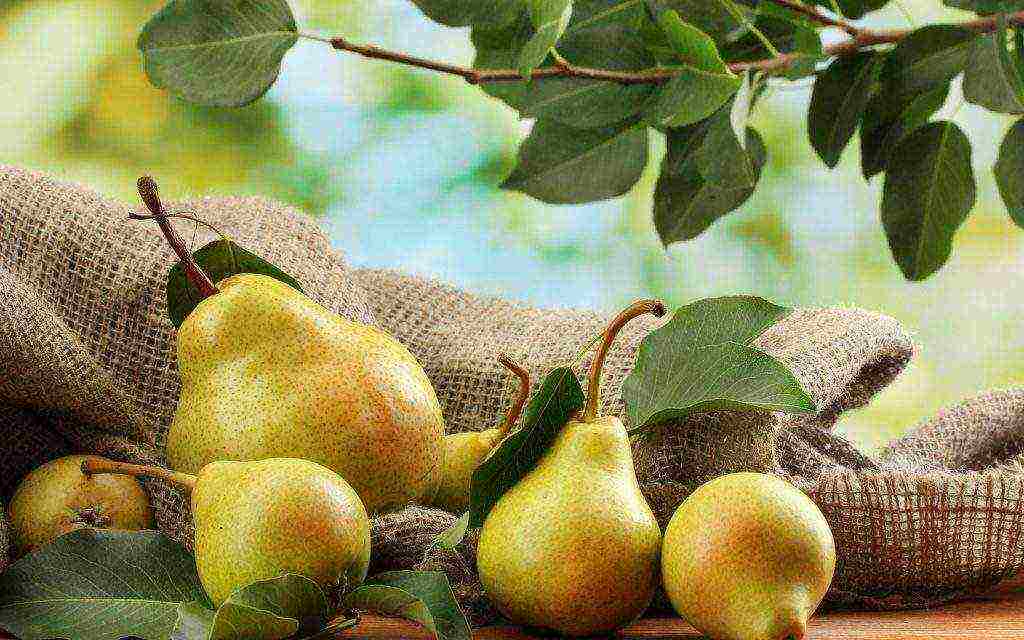
The best pear varieties for central Russia, the Moscow region and the Urals
The varieties listed below are especially popular with gardeners, since, unlike southern varieties, they can grow on any soil, while giving a bountiful harvest and not losing their properties even during prolonged frosts. Special attention was paid by breeders to resistance to pests and various diseases, and in this, too, many varieties for the middle lane have no equal.
Among the relatively new varieties, the following varieties can be distinguished:
Cathedral
In terms of timing, it refers to summer ripening. Fruiting every year, the first harvest appears in the 4th year after planting the seedlings. The culture is unpretentious, tall (more than 3 meters), with a very dense crown, which is recommended to be cut every 2-3 years to give access to sunlight. Fruits are regular pear-shaped, medium in size, weight does not exceed 150 grams. The taste is sweet with a sour aftertaste. Stored for no more than 3 weeks. They are used fresh, as well as for workpieces and conservation. If the best varieties of pears are for the Moscow region, then the Cathedral fits perfectly.

Cathedral
Muscovite
Medium ripening early-growing variety. The yield is high - an average of 35-40 kg per tree. An unpretentious crop, resistant to drought, pests and diseases. The fruits do not crumble as they ripen, which makes it possible to harvest and guarantee its long-term storage and transportability.
Pears are uneven in size, medium size - up to 150 gr.The taste is sweet, the pulp is tart, very aromatic. It is stored for 3 months under the condition of stable temperature (0- + 10C), stacking in pallets in one row and absence of drafts in the room.
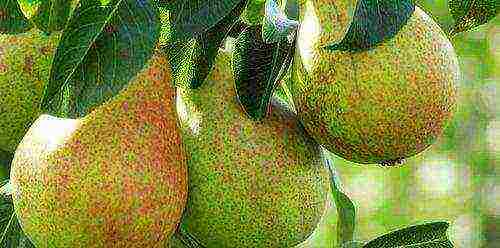
Muscovite
Read with this article: The best varieties of apple trees
Rogneda
A relatively new variety, registered only at the end of 1997. Bred by breeders specifically for central Russia and the northern regions, the Urals and Siberia. Differs in a high degree of resistance to frost, diseases, poor soil fertility. Gives a large harvest, bears fruit annually, starting from the fourth year after planting. A rootstock with quince is recommended, which gives an increase in fruit and a more pronounced taste.
Fruits are more round, uneven in size and medium in weight (120-150 gr.). The pulp is firm and crispy. They do not fall as they ripen, but when they fall they beat hard. Leaving the pear for storage, it is necessary to sort it out and remove broken or rotten fruits. Suitable for fresh consumption and preservation.
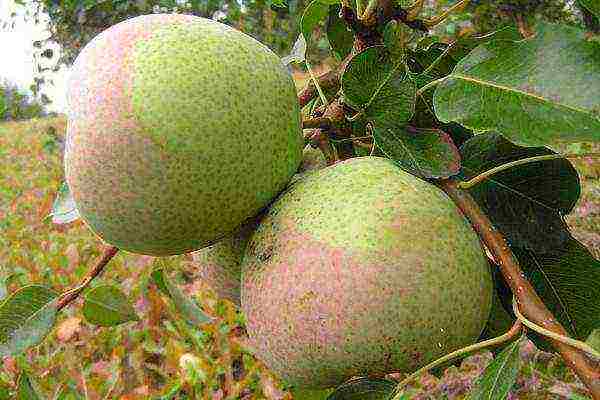
Rogneda
VIDEO: Pear Cider. Simply and easily
Miracle woman
Winter variety of medium height and excellent survival rate in different soils. The culture can withstand any frost (with high-quality insulation, even up to -500C). Begins to bear fruit at the age of 4 years and brings a consistently high yield every year. The fruits are large enough - 200-220 grams, the taste is sweet with a sour aftertaste, a very pronounced aroma. Medium transportability - prone to falling off as it ripens, which significantly complicates the harvest.
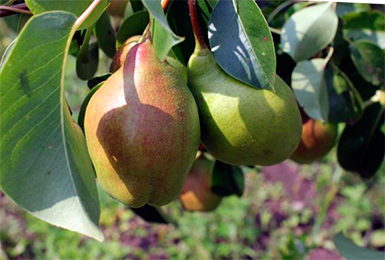
Miracle woman
Festive
Winter variety resistant to diseases and pests with above average yields. About 30-35 kg of pears are harvested from one tree. The crown is pyramidal and requires regular pruning to form a comfortable bed and provide access to sunlight to each branch.
Fruits are small - up to 100 grams, the pulp is elastic, juicy, darkens quickly in the fresh air. The taste is sweet and sour. Keeping quality is average, depending on the time of collection and the quality of the pears themselves.
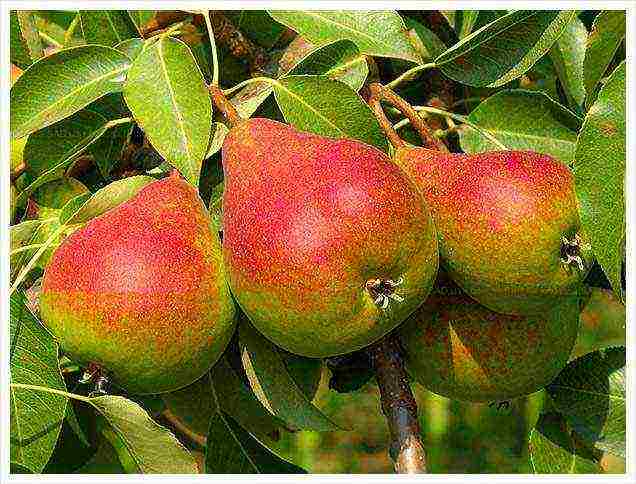
Festive
The best varieties of early ripening pears
They are in constant demand, as they allow you to get a good harvest in the middle of summer or closer to the beginning of autumn. Which depends on the region of planting. It should be noted that such fruits are not stored for long - no more than two weeks, but the taste is very rich, although a sour aftertaste often remains. For a short period of solar activity, the fruits do not have time to be fully loaded, respectively, these are the best varieties of pears for those who love fruits with sourness.
Early July
Judging by the name and popularity among gardeners, the most favorite pear variety, which gives a consistently good harvest every year. Fruits of medium size, weighing 100-120 grams, the same size, regular pear-shaped. Keeping quality is minimal - up to one and a half weeks. The taste is pronounced, with a predominance of sweetness. The pulp is elastic, practically does not darken in air. Suitable for mixing and juicing. Not recommended for preservation, as it quickly loses flavor intensity. It is not subject to transportation over long distances due to the low shelf life.
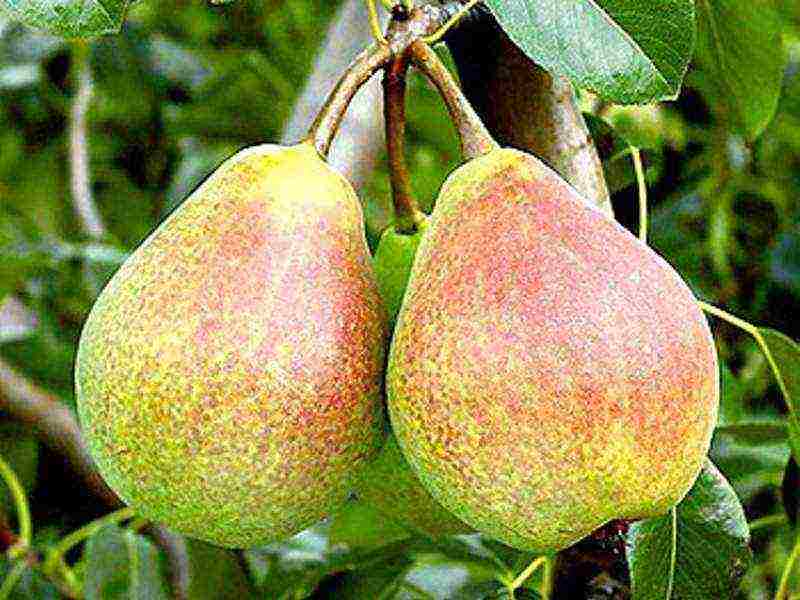
Early July
Moldavian Early
A hybrid summer variety bred by breeders from two varieties. Differs in high frost resistance, is not susceptible to attack by pests and typical diseases. Grows on different types of soil. Requires maintenance, application of organic fertilizers and regular pruning of the crown to form a comfortable bed.
Medium-sized fruits - up to 150 grams, with dense elastic pulp with minimal signs of rustiness (when the cut fruit is outdoors for more than 15 minutes). Harvesting maturity begins in the first half of August and lasts until early September.
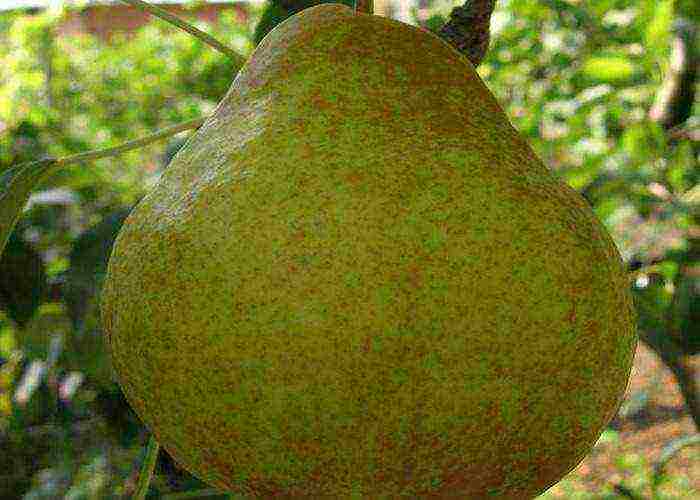
Moldavian Early
Early ripening (Skorospelka)
Bred in 1999 by crossing three varieties.Today it is a fast growing tall variety, frost and disease resistant, bearing fruit annually. The first harvest occurs in the 5th year of growth. Fruits are medium, uniform in size, minimum keeping quality - with proper organization, they can lie no more than two weeks. It is consumed mainly fresh and is excellent for making juices due to its soft and juicy pulp. The skin is thin. There is good scab resistance, but is often affected by moniliosis.
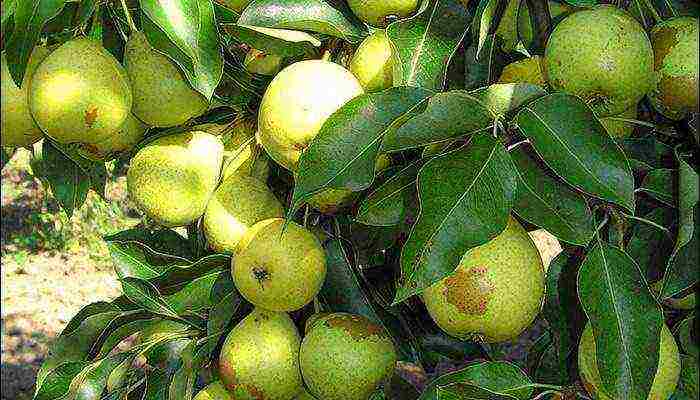
Early ripening (Skorospelka)
The best sweet pear varieties
Fully ripe pears are mostly sweet, but there are varieties that can be eaten even unripe and will be just as sweet. Among these there are the best varieties of pears for the Moscow region, reviews of which can be found on the net and on the forums of gardeners.
Autumn sweet
Without exaggeration, the best variety for the middle zone, the Urals and Siberia, which, in terms of richness of taste and juiciness, is not inferior to any southern form. At the same time, a high degree of resistance to prolonged frosts, pests and insects is noted. Fruits are bright yellow, fragrant, firm, juicy pulp. Storability is average, stored for more than a month, provided that the storage is properly organized. The first crop appears in the second decade of September and until the end of October.

Autumn sweet
Buttery sweet
The favorite variety of pears of Moscow Region gardeners, who are attracted by the taste, juiciness, the possibility of long-term storage, versatility in use. Due to the high concentration of sugar, pears can be eaten not only fresh, but also made into wine, made into liqueurs and other preserves.
The variety is resistant to all diseases, without exception, is unpretentious in care, does not require a rootstock. At the end of autumn, it is advisable to insulate the trees, cover the root zone with dry manure and cover with spruce paws.

Buttery sweet
Read with this article: Which manure is better for fertilizing the soil
Prominent (Bumpy)
The sweetest pear of all the above varieties with only one drawback - it has a minimum keeping quality. The fruit is not stored even for several days, it is recommended either to eat it immediately or send it for conservation.
Like all varieties for central Russia, they are winter-hardy, hardy, not susceptible to attacks by insects and diseases, and bear fruit in the 5th year after planting.
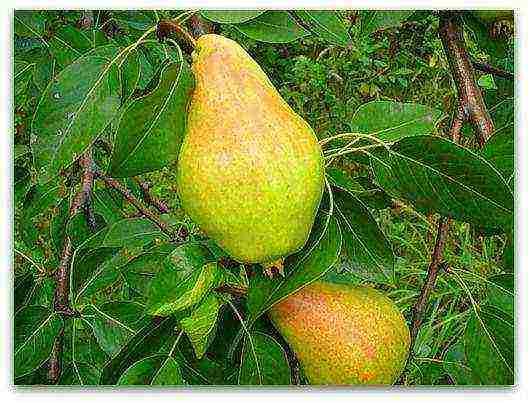
Prominent
VIDEO: How to choose the right pear variety
As you know, pear varieties are subdivided into winter, autumn and summer varieties. Each category differs not only in terms of ripening, taste, but also in terms of storage of fruits... So, which varieties can be attributed to winter, and which ripen in summer, see the description below.
Summer pear varieties
August dew
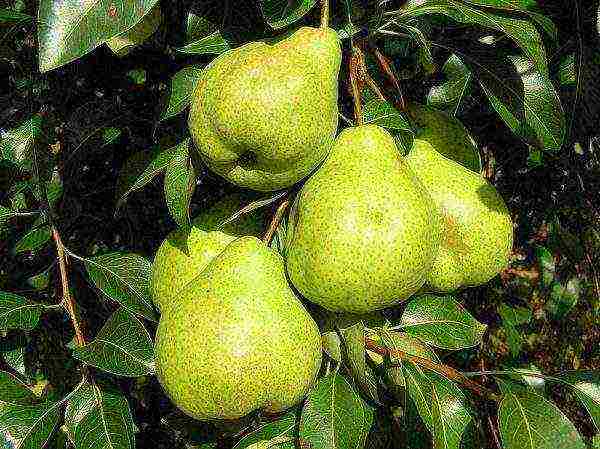 Pear August dew
Pear August dew
The undisputed favorite among summer pear varieties is August Dew, the result of a crossing of Tenderness and Triumph Pakgam varieties. The tree is rather low, less than 10 m in height, the bark is gray, smooth, the buds quickly "wake up" after winter. Branches are spreading, slightly drooping, curved. The leaves are oblong, medium in size, dark green in color. Fruits are of medium size, ripen in mid-summer. The taste is quite sweet, juicy, with white pulp and delicate skin.
Unfortunately, it is not suitable for long-term storage, the pear quickly turns brown and disappears. It is itself resistant to diseases and pests, easily tolerates winters, bears fruit every year, increasing the number of fruits. The disadvantage of this variety is that it constantly needs to trim the crown, because of this, the fruits become smaller.
Bere Giffard
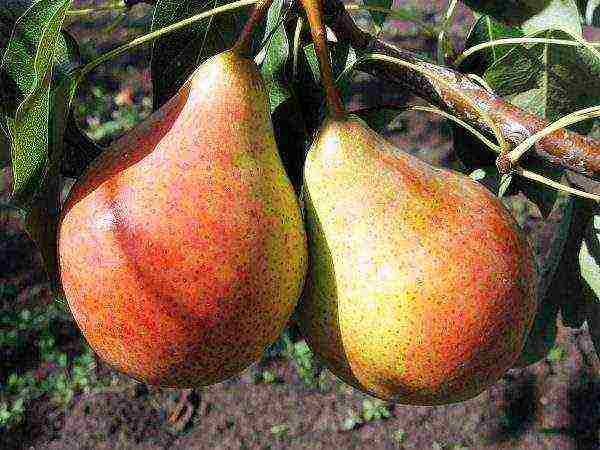 Pear variety Bere Giffard
Pear variety Bere Giffard
The same applies to summer varieties of pears. They differ from other varieties with their "ruddy" fruits, red-orange tones on one side of the pear, and light green shades on the other side. Formed on a branch in bundles, from 2 to 6 pieces, and keep so until fully ripe.Due to the high yield, additional supports are often required, otherwise the branches may break under the weight of the fruit.
The fruits are tender, have a sweet taste, juicy, with white flesh. The tree reaches more than 10 m in height, a sparse crown, branches are slightly drooping and thin. The crown is brown, peels off. The leaf plate is dark green, oblong, with smooth edges. The variety does not tolerate severe winters, therefore, young seedlings require shelter. Fruits are poorly preserved when plucked, no more than a week.
Victoria
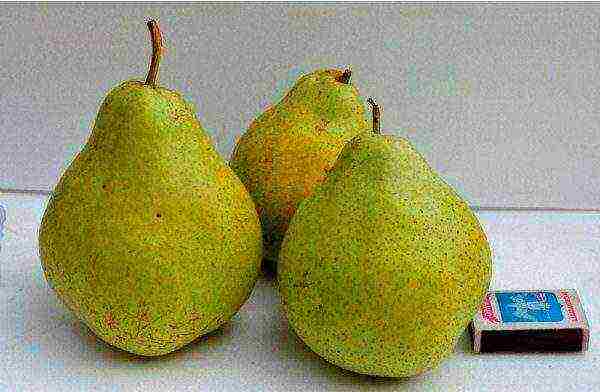 Winter-hardy pear variety Victoria
Winter-hardy pear variety Victoria
This variety is distinguished by its winter hardiness, is not afraid of drought and is rarely exposed to diseases and pests. It appeared as a result of crossing the varieties Bere Bosk and Tolstobezhka. Medium tree, 8-10 m, with a dense crown, has a pyramidal trunk shape, branches are long and thin. The variety is characterized by late vegetation, flowering. Productivity is high, more than 150 kg of harvest is harvested from an adult tree per year.
The pear begins to ripen in the second half of August, reaching its peak of maturity only by the middle of September. The fruits have a regular pear-shaped shape, with a smooth and thin skin.... The pear tastes sweet, with juicy pulp, and has a pleasant aroma. It is good to make jam and jams from this variety. But the pear is stored for a short time, in a torn form it does not deteriorate for about 3 days, it can hang on the tree for no more than a week, then it falls off.
Victoria is only half pollinated. To increase yields, it is recommended to plant it next to varieties such as Bere Dumont,
Williams
Red.
Duchess
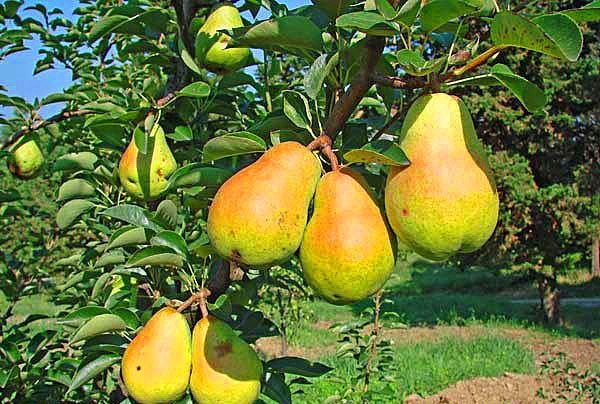 Summer pear variety Duchess
Summer pear variety Duchess
The name of the variety, translated as Duchess, was bred by an English breeder in Wheeler. The tree is not tall, 6-7 m, with a dense crown, branches are spreading, thin... The crown is a light brown tree, smooth.
Fruits begin to ripen in mid-August, the fruits are bright yellow. On average, one pear can weigh more than 150 g, are located on the branches singly or in groups of 4-6 pears. Stored up to 40 days on a tree and no more than 2 weeks when torn off... The fruit tastes juicy, sweet, with a thin skin and delicate aroma. The taste contains light notes of nutmeg and spices. The variety is frost-hardy, not afraid of cold weather. It is also not affected by scab, but copperhead and aphids are on the tree very often.
How can you tell if summer pears can be picked from the tree? Firstly, if fallen fruits have already begun to appear on the ground, then the harvest is ready. Secondly, it can be determined by the color of the fruit, the ripe fruits become yellowish. Thirdly, if the pear has become soft to the touch, then it can be safely removed from the tree.
Severyanka
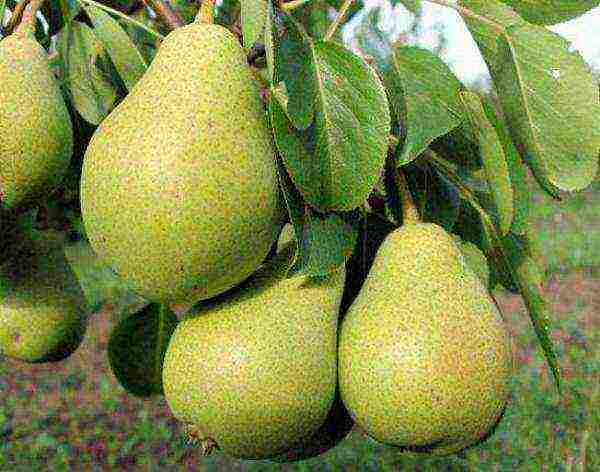 Pear variety Severyanka
Pear variety Severyanka
It was bred by breeders for the northern regions, hence its name. The variety is medium-sized, tree height from 3 to 6 m, with a dense crown and a pyramidal trunk shape... Young seedlings easily tolerate planting and quickly begin their growth, but the tree begins to bear fruit in 4-5 years. The leaves of the tree are light green, pointed in shape, with smooth edges. It blooms in early spring, has more than 6 petals in the inflorescence /
A variety with a high yield, the fruits are strewn with branches, every year the harvest becomes larger, in the same way, the tree bears fruit every year. The pear is large, up to 200 grams each fruit, they are formed into small clusters of 4-6 pears... At the beginning of ripening, they have green tones, and then they acquire yellowish-orange shades. The skin of the fruit is loose, sometimes rather rough. The taste is not inferior to other varieties, sweet, with juicy pulp, has a sour-tart taste and light aroma. But there are not many seeds in the pear, they are located in special chambers in the heart of the fruit. It tolerates winters, diseases and pests well enough, does not need special care.
Cathedral
 Rapid pear variety Cathedral
Rapid pear variety Cathedral
The same applies to summer, early-growing varieties.It was bred by crossing Lesnaya Krasavitsa and Duchess Bedro varieties. It grows mainly in the Central regions, but due to its resistance to frost, it grows easily in the regions of the North. The tree is medium-sized, from 4 m in height and above, with a wide and dense crown, the branches look up... The trunk is smooth, brown-gray. Young shoots are slightly drooping, reddish-brown in color, fruiting occurs on them. Leaves are green, smooth, medium in size.
Fruiting begins from the 6th year, the weight of a pear can exceed 130 grams. Ripening occurs in mid-August, the fruits remain on the tree for no more than 2 weeks, even less when plucked. Lemon-colored fruit with many splashes, change their shades closer from autumn to red-orange, which indicates full ripening of the fruit. The skin is thin, the flesh is creamy or white, sweet with a pleasant aroma, medium density. In the middle of the fruit are brown seeds, elongated.
Summer varieties of pears ripen by mid-summer, it is important to remember about their proper care. Summer pears love moisture in spring and especially during fruit formation. For the harvest to be faster, the tree needs annual pruning and feeding.
Winter
Saratovka
Obtained as a result of crossing the varieties Bere and Bergamot... They worked on a new variety at the Saratov State Agrarian University named after V.I. Vavilov. Refers to winter, plucked fruits under the right conditions can be stored until February!
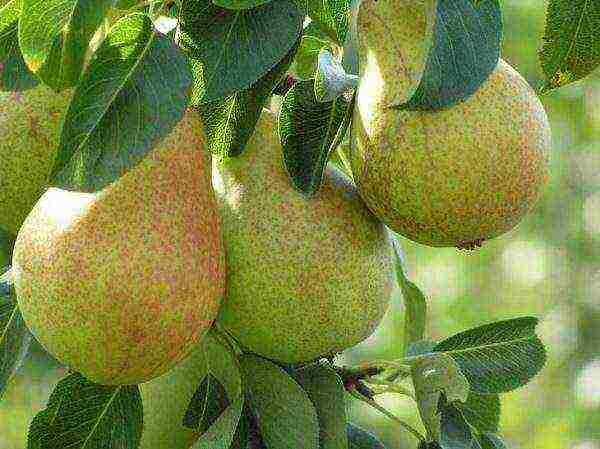 Frost-resistant pear variety Saratovka
Frost-resistant pear variety Saratovka
Saratovka is a medium-sized variety, the branches look straight up, the tree is more than 10 m high... The crown is dense, the trunk is brown-gray. Young leaves of light green color, oval, with smooth edges. By autumn, they are painted in dark green tones. The disadvantage is the dense crown, which needs proper pruning every year, otherwise, the tree reduces the amount of harvest, more energy is given to the formation of young shoots.
The yield is high, but the tree begins to bear fruit only in the 5th year. The fruits are sweet, firm, with a thick skin, lemon color, with a red-orange blush. It begins to ripen from mid-August, remains on the tree for a long time, until the end of September. The variety is winter-hardy, rarely exposed to diseases and pests, also tolerates long-term transportation, does not lose taste and external qualities.
Kondratyevka
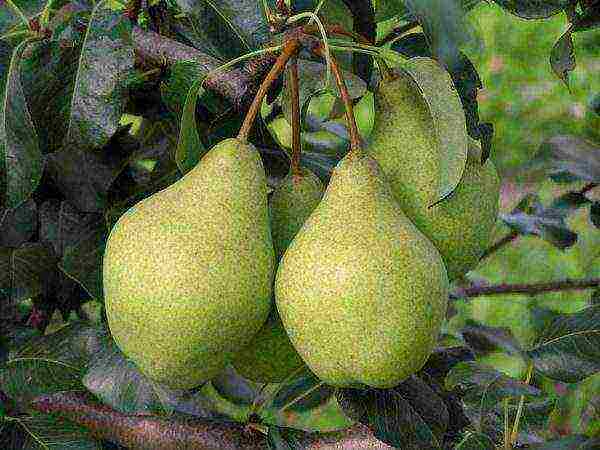 High-yielding pear variety Kondratyevka
High-yielding pear variety Kondratyevka
Winter pear variety, fruit ripening occurs in early and mid-September. High yields start from 5 years after planting. Gives a bountiful harvest annually, the tree does not need rest. The mass of one pear reaches up to 230 grams... The fruits are sweet, juicy, with delicate pulp and spicy aroma. They have the correct pear-shaped shape and are attached to a thick curved peduncle. They are green when ripe, slightly yellowish.
The tree itself is quite tall, 10-12 m in height, with a pyramidal trunk and slightly drooping branches. The variety differs from others in its slow growth, it mainly builds up green mass. But then it bears a large number of fruits. Survives severe cold quite easily, tolerant of various diseases and pests.
Pass-Krasan
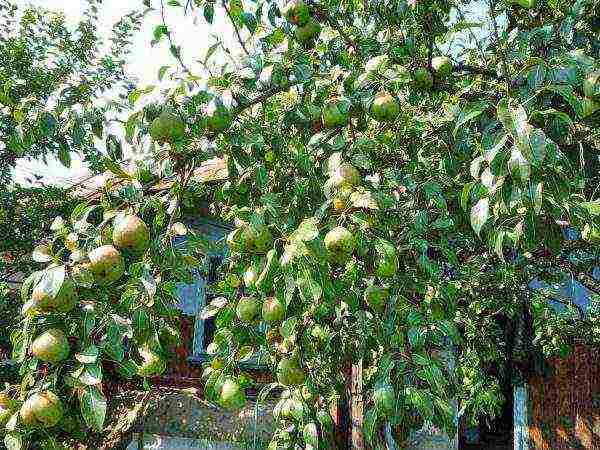 Pass-Krasan pear requires a lot of sunlight
Pass-Krasan pear requires a lot of sunlight
The same applies to winter pear varieties. Unlike other varieties that do not need special conditions, this hybrid requires increased attention. Prefers to grow only in sunny places, does not tolerate close proximity to other seedlings. From a lack of sunlight, its fruits become sour and do not reach the required size... He also loves moisture and well-fertilized soil. Extremely poorly tolerated cold and susceptible to many diseases.
But subject to all conditions, it gives large, juicy fruits with a slight sour taste.It bears fruit annually, does not require rest, but you should not expect a large amount of harvest from this variety. The mass of one pear can reach more than 200 grams, large pears are light green in color. The right time to harvest is mid to late October, by this time the fruits reach their optimal size and retain their taste. The advantage is the ability of the fruit to last until next spring.
In order for the variety to begin bearing fruit earlier, it is better to graft young seedlings on quince.
May Day
 The fruits of the Pervomayskaya variety can last up to 8 months.
The fruits of the Pervomayskaya variety can last up to 8 months.
The result of crossing pears Daughter of Dawn and Late. This variety differs from others in the storage duration of the plucked fruits, up to 250 days! The pear is not demanding to care for, it is frost-resistant. She rarely gets sick, she doesn't care about many pests. The height of the tree is more than 10 m, with a spreading crown... Young shoots are rather thin, gray-brown, smooth. The leaves are round in shape, with smooth edges, slightly curved upwards.
Average fruit weight from 140 grams, have the correct shape, smooth and thin skin. During the summer, the fruits are green, towards autumn they acquire brown-red tones. Attached to branches with a strong stalk, forming a cluster of 4-6 fruits. Sweet to taste, with a pleasant aroma, slightly tart, with white pulp, has an attractive appearance and taste. The variety has a high yield, but fruiting begins at 5-6 years.
Lyre
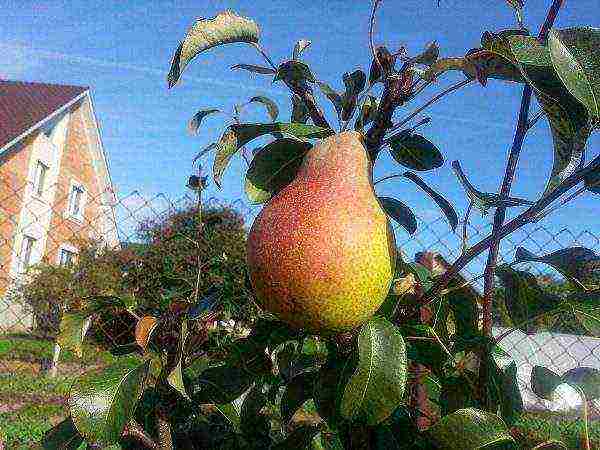 Pear Lear
Pear Lear
Winter variety, with a high storage capacity of fruits, up to several months. A tree with a wide pyramidal trunk, light brown in color. Branches of medium thickness, most often gray, smooth. Leaves are elongated, smooth, dark green shades.
Pear weight more than 200 grams, fruits of greenish tones, acquire a yellowish tint. They have an elongated fruit shape, with a smooth and thin skin. Harvesting can start from September. The pear is sweet to taste, with white juicy pulp. The yield is high, the tree does not need interruptions, but the harvest begins to appear only 4-5 years after planting. Resistant to diseases and pests, but has an average winter hardiness. Especially young seedlings need additional shelter for the winter.
Patriotic
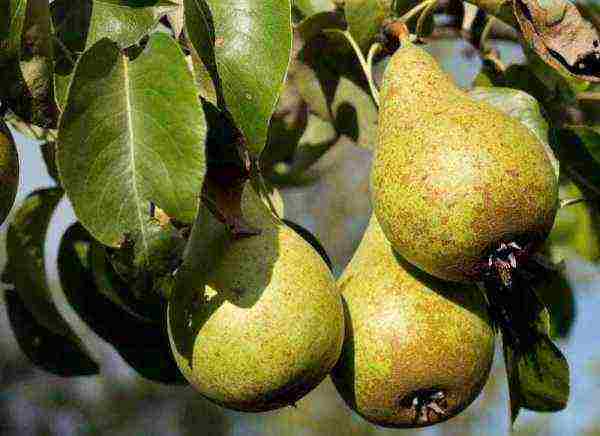 Winter variety of pears Patriotic
Winter variety of pears Patriotic
The result of the joint work of O.S. Kharchenko, A.V. Krasovsky and A.F. Mileshko. Blooms in late spring, white, rounded flowers with a light aroma. The tree itself is tall, more than 10 m, with a spreading crown, straight branches. The trunk is brown, smooth, regular in shape.
Fruits are large, light green in color, more yellow when fully ripe. Fruit weight up to 180 grams, has an attractive view for sale, also protects the view during long-term transportation. It is recommended to harvest the tree in early October, the fruits can be stored for several months in a cool place. It produces crops regularly, the tree rarely gets sick and is almost not damaged by insects. It is also frost-resistant and does not need special care, it tolerates scab and thermal burns of leaves. Ripe fruits are stored for several months.
For pears to be stored longer, it is important for them to provide the necessary conditions. The fruit must not be damaged or dented when harvested. Also, the pear should be dry and wrapped in newspaper or paper. It is better to store in small boxes, in 2-3 rows. The room should not be damp, too hot and humid. The optimum storage temperature is + 8-14 degrees, in a dark place.
Late
Dessert Rossoshanskaya late
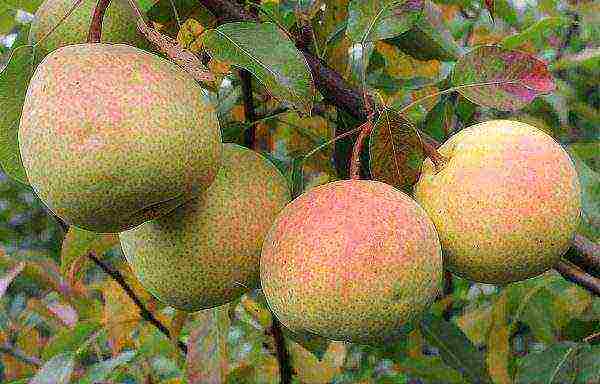 Rossoshanskaya - pear with fruits of autumn ripening period
Rossoshanskaya - pear with fruits of autumn ripening period
Belongs to late varieties, ripening of fruits comes at the beginning of September. Dessert pear can be stored until January under proper storage conditions.... A hybrid, the result of crossing the varieties Lyubimitsa Klappa and Tonkovotka, bred in 1952.The tree is vigorous, more than 6 m in height, the seedling has a narrow pyramidal trunk, gray in color, an adult tree forms a wide and smooth trunk. The crown of the pear is branched, young branches are gray, looking up.
The fruit is large enough, weighing up to 180 grams, dark green tones at the beginning of ripening and brown-red shades by autumn. Fastened on branches of 6 pieces on thick stalks. Harvesting begins at 3 - 4 years, the yield percentage is high. Sweet to taste, with soft skin and juicy pulp.
Belarusian
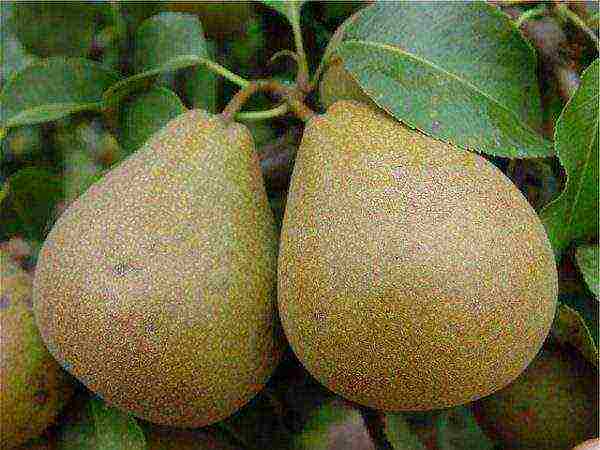 Pear Belarusian late
Pear Belarusian late
Bred in Belarus. The variety is late, ripening at the beginning of September. Small tree, no more than 3.5 m in height, branches look straight up, the crown is gray-brown, smooth. Leaves are light green in color, oblong in shape, with uneven edges. Flowering occurs at the beginning of spring, the inflorescences are white, with a pleasant aroma.
Fruits are dull, light green in color, changing to orange-red shades during the summer. The peel of the pear is rough, rather dense, with small black spots. The stalks are short, the pear is squeezed onto the branches in pairs. The pear tastes fleshy, with white flesh, juicy, has a slight sourness... The pear is winter-hardy, not subject to pests and diseases. Minus - it does not bear fruit every year, it needs rest.
Variety
Belarusian
is not always capable of pollinating on its own, therefore, in order to have a successful harvest, it is recommended to plant additional pollinated varieties on the site, for example,
Conference
or Bere loshitskaya.
Olivier de Serre
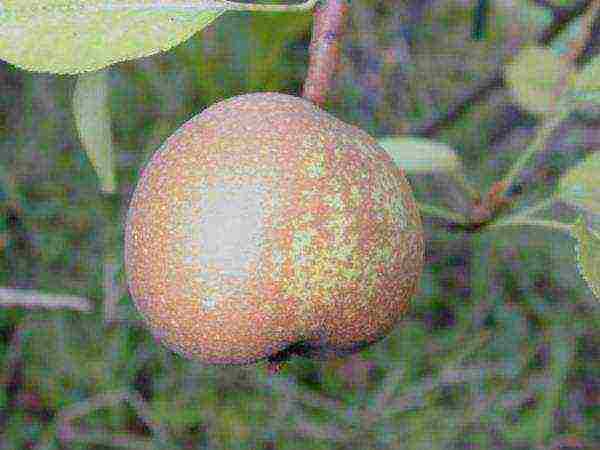 Olivier de Serre
Olivier de Serre
The work of a French breeder. The variety is quite capricious, requires special conditions for growth and careful care. The tree is medium-sized, the crown is compact, the branches are directed upwards. Crown of brownish shades, smooth, slightly flaky... During the summer, it forms many new branches, which reduces the yield, so it is important to remove excess branches in the fall. The leaves are shiny, dark green, rounded.
Fruits can weigh more than 400 grams... In appearance, the fruits are small, round in shape, with a thick skin. The whole fruit is covered with red spots, the surface is bumpy, uneven. The pear is sweet, with white fleshy pulp and a light pleasant aroma. The pear ripens by September and is stored harvested until spring. It is resistant to diseases, but in severe winters it needs additional shelter, otherwise the amount of harvest in the next year decreases.
Bere Ardanpon
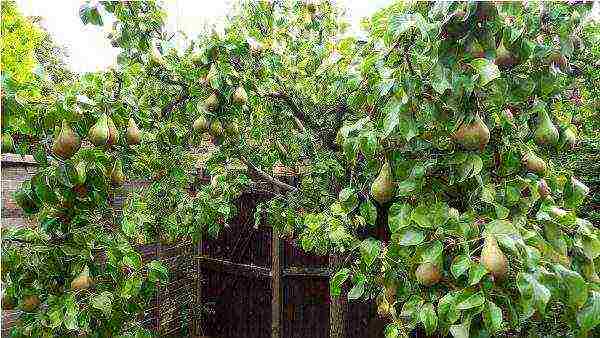 Pear of late ripening Bere Ardanpon
Pear of late ripening Bere Ardanpon
It was bred in Belgium by N. Ardanpon in 1759. This winter-hardy undersized hybrid requires special care. It prefers to grow in the sun, heat and well-moisturized soil - only under these conditions does the tree bear fruit. The tree is vigorous, with a dense crown of brownish-gray color... Young branches are thin, not lowered, The leaf blade is pointed, dark green, slightly pointed in shape. Blooms in early spring, with white fragrant inflorescences.
The fruits are large, green in mid-summer and reddish when fully ripe closer to autumn. A pear with a thin, smooth skin. This variety fell in love with gardeners because of its attractive presentation., which persists until cold weather. The pear is sweet to taste, with white, fleshy flesh. It tolerates winter firmly, but it is better to cover young seedlings.
Hera
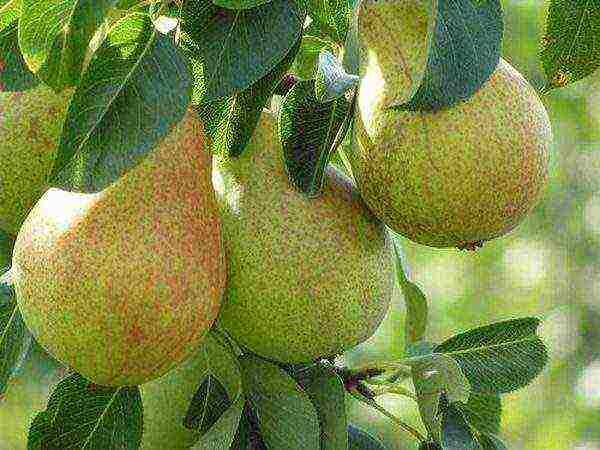 The Gera variety is famous for its large fruits.
The Gera variety is famous for its large fruits.
The same applies to winter varieties, which appeared as a result of crossing Reale Turin and Daughter of the Dawn. The variety is not particularly different from others, but because of its large fruits, it fell in love with gardeners. One pear can weigh up to 280 grams! In addition, the fruits have light green hues, which change to reddish during the ripening process. Not inferior in taste, pears are sweet, with fine-grained cream-colored pulp. They have a delicate, slightly sour taste, with a pleasant aroma.
The tree is medium-sized, no more than 6 m high, with spreading branches, crown, brownish color. Able to give a large amount of harvest annually, not picky about conditions and care. Plucked fruits can be stored for several months. In addition, the variety is quite resistant to diseases, not afraid of insects, frost-resistant.
In ancient Greece, pear fruits were used as a remedy for nausea.
Miracle woman
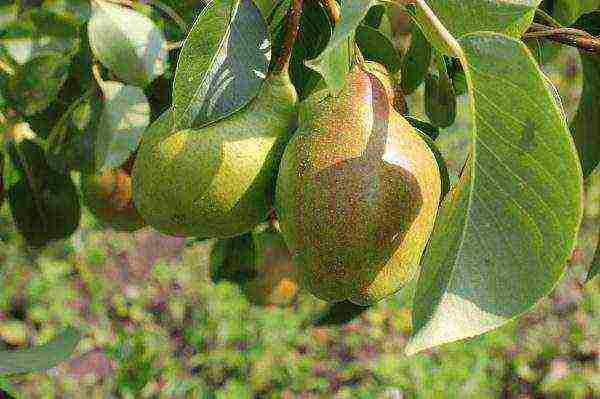 Pear Miracle
Pear Miracle
Another winter pear, a hybrid obtained by crossing the Daughter of Zarya and Talgar beauty varieties. Possesses excellent resistance to frost and disease... Has a pyramidal crown, no more than 5 m high. The branches are thin, look up, gray-brown in color. The leaves are rounded, dark green in color, small light streaks are clearly visible. Blooms in early spring, white fragrant inflorescences.
High yield variety, by weight one fruit from 140 to 210 grams, can remain on the tree for a long time and can be stored for a long time when assembled. Fruits are light green in color; towards autumn they become yellowish, slightly elongated. Sweet to taste, with fleshy pulp, have a delicate pleasant aroma.
Autumn
Autumn garden varieties differ from others in the long term storage in assembled form, they are not inferior in taste to summer or winter ones.
Veles
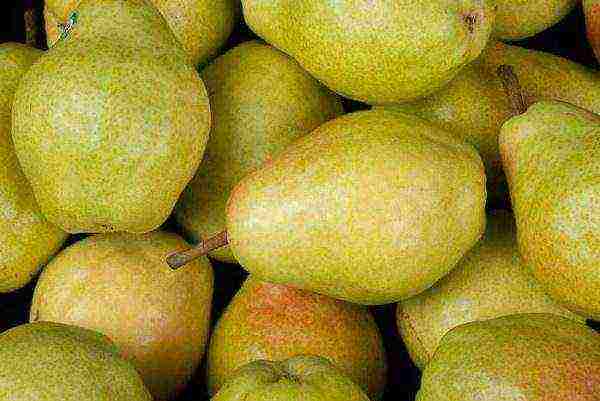 Veles pear variety
Veles pear variety
Autumn pear variety, one of the best. The fruits are large enough, the average weight of a pear is from 150 grams and above... Fruits are regular pear-shaped: narrow at the stalk and rounded at the bottom. On the branches they grow in small clusters, 3-4 pears each. The Veles pear ripens at the end of August, remains on the tree until October. It has a beautiful appearance, until the end of summer, the fruits are dark green, and when ripe, they become red-orange tones. The taste is sweet, juicy, with fleshy pulp and thin skin.
The height of the tree is no more than 8 m, with drooping branches and a pyramidal shape of the trunk, gray-brown in color. Young branches are formed throughout the summer, which affects the amount of the harvest, it is recommended to prune in the fall. Resistant to frost, disease and pests.
Bere Moskovskaya
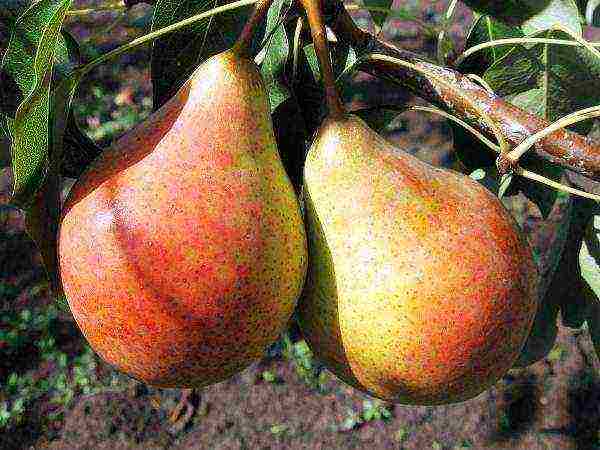 Bitter-tart pear varieties Bere Moscowskaya
Bitter-tart pear varieties Bere Moscowskaya
Frost-resistant, almost not exposed to diseases and pests. It appeared as a result of pollination of the Olga variety with pollen from the Lesnaya Krasavitsa and Lyubimitsa Klappa varieties. A tree no more than 6-8 m high... The crown of the pear is round, light brown in color. Young branches are rather thin, drooping, gray or brown in color. The leaf plate is dark green, rounded. The pear blooms in early spring.
Fruits are slightly bumpy, light green shades, there is a slight blush closer to autumn.It is best to remove fruits that are slightly green and firm in early autumn., so they keep better and stay longer, up to several months in a cool and dark place. If the pear tastes slightly tart, with sourness, it means that the pear lacks moisture. With proper care, the pear becomes sweet and fleshy, with a delicate white flesh. In general, this variety is not capricious when leaving.
Red-sided
 Pear variety Red-sided
Pear variety Red-sided
The misconception that this variety belongs to the winter, it is not, the variety is autumn ripening. It was obtained as a result of crossing the varieties Zheltoplodnaya and Tenderness. Resistant to diseases and pests, especially scab... It is frost-resistant, gives a good harvest from year to year. The crown is rounded, the branches are slightly drooping, brown-gray in color. Leaves are slightly pointed, light green shades in spring and dark green tones closer to autumn.
Does not require special care, can grow in small shade, under taller trees, but loves moisture. Fruits of medium size, weighing no more than 200 grams... Green pears change their shades to a raspberry blush as they ripen. Sweet to taste, with juicy fine-grained pulp and thin skin. Stick to branches, on short, curved stalks.The fruits are able to survive for a long time, both on the tree and in the harvested state, they are not afraid of transportation.
In memory of Yakovlev
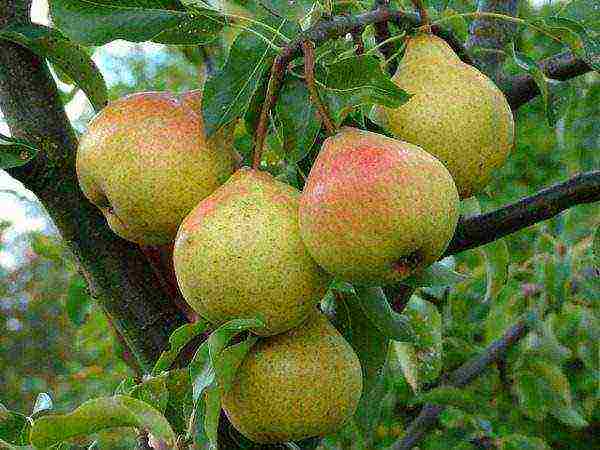 Pear variety of high winter hardiness in Memory of Yakovlev
Pear variety of high winter hardiness in Memory of Yakovlev
A medium-sized tree with a dense crown. The height of the tree does not exceed 1.5-2m, with a spherical crown. Young branches are thin, looking up, brown-gray in color with small thorns. The leaves are dark green, ovoid, with smooth edges. The harvest gives for 6-8 years... The Pamyati Yakovlev variety is popular among gardeners due to regular fruiting and unpretentious care.
Pears with smooth and thin skin, weighing no more than 200 grams. The fruits are collected in groups of 5-7 pears. The pear is sweet to taste, with juicy pulp and pleasant aroma. The fruits are golden in color, slightly reddish at the end of ripening. Full ripening of fruits occurs in mid-October.... The pear is stored on the tree for a long time, does not fall off, and in the assembled state it can lie for several months. High yield, which increases every year the tree grows. More than 30 kg of ripe pears are harvested from an adult tree per year. In addition, it is capable not only of self-pollination, but also pollinates other varieties of pears. It greatly simplifies the care of a pear that it is winter-hardy and unpretentious in care.
For the first time the word "pear" was mentioned in chronicles in the 12th century, and sounded like "hrusha". And all because of the characteristic crunch that was published when the fruit was bitten.
Muscovite
 Branch of pear Moskvichka with fruits
Branch of pear Moskvichka with fruits
Obtained as a result of pollination of one of the American Kieffer pear varieties. Possesses a standard shape, with a rather dense and spreading crown, light gray colors, which eventually changes shades to brown tones. Forms new curved shoots quickly. The foliage is light green in color, with an oval shape, slightly curved in the center. This variety produces a bountiful harvest in the southwestern regions. The first harvest is formed in 3-4 years.
Muscovites are medium-sized fruits, up to 150 grams. They have the correct pear-shaped shape. They have a greenish-yellow hue, which changes towards burgundy-crimson tones by the end of summer. The skin is thin, fleshy with a juicy pulp with a pronounced sweet-sour taste. It is recommended to pick pears when they are slightly underripe, because after lying in the room for a couple of days, the pear ripens and retains its taste. Under the right storage conditions, the fruits are able not to spoil for several months.... High resistance to scab and rot, also not afraid of frost.
Marble
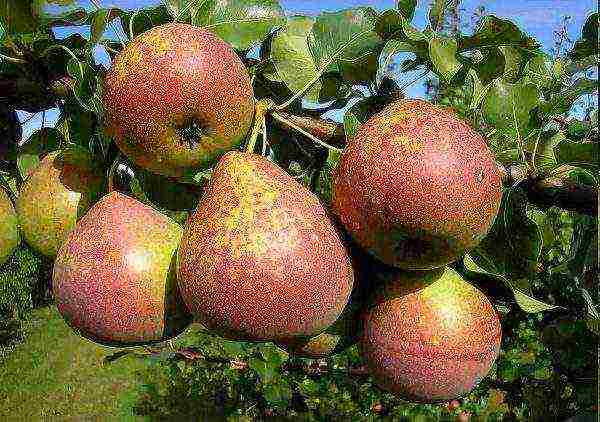 Marble pear fruits
Marble pear fruits
The fruit of the crossing of Bere Zimnaya Michurina and Lesnoy Krasavitsa varieties. The harvest of this variety ripens by the very beginning of autumn, the first fruits can be picked at the beginning of September. Differs from others in the height and density of the crown, the height of the tree is more than 8 m... Many light brown thin branches are formed every year, but pear shoots are extremely rare. Blooms in early spring with white fragrant inflorescences. The foliage is dark green in color.
The fruits are large, from 170 grams, with yellowish-green hues and a slight blush. The pear is also distinguished by the correct conical shape of the fruit. The pulp is coarse, tender, juicy. Rather dense rind, with small dots of a rusty color. The Marble variety, like other autumn pears, is frost-resistant, not afraid of diseases and pests. The tree begins to yield only 5 years, but the yield percentage is high, the pear is able to please with a large amount of harvest every year.
Pear for the Volga region and central Russia
Chizhovskaya
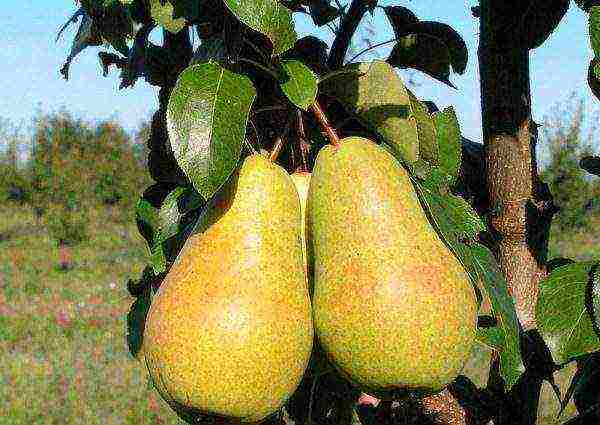 Winter-hardy pear Chizhovskaya
Winter-hardy pear Chizhovskaya
Olga and Lesnaya Krasavitsa were taken as the "parental" varieties, as a result of the long work of S.T. Chizhov and S.P. Potapov and the Chizhovskaya variety was bred. One of the popular self-pollinated varieties in the middle lane, especially in the Volga region and surrounding areas... The tree is no more than 3 m high, the young tree has a narrow crown, grayish shades.Older branches acquire a brownish color, branches look up, medium in thickness, slightly curved. Leaves are oval, dark green in color with smooth edges.
By themselves, the fruits weighing no more than 150 grams. At the beginning of summer, the pear is of light green tones, the fruit is quite hard, but closer to autumn it acquires yellow shades and becomes soft. In this state, the Chizhovskaya pear will not hang on the tree for a long time, therefore it is recommended to pick it at the beginning of autumn. Green fruits can last for several weeks.... Sweet and fleshy on the palate, ripens in mid-August. They have a white, medium-grained pulp with a pleasant aroma. In addition, she inherited frost and disease resistance from her relatives.
The peculiarity of the variety is that the older the tree, the smaller the fruits. You can fight this with timely pruning.
Lada
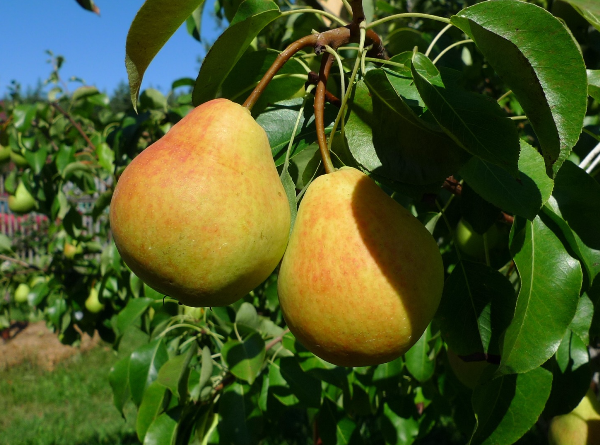 Pear Lada belongs to the early summer varieties
Pear Lada belongs to the early summer varieties
The result of crossing the varieties Lesnaya Krasavitsa and Olga, a variety suitable for planting in the middle lane. Differs in early maturity of fruits, you can taste fresh fruits already in the middle of summer... Lada is frost-resistant, is not susceptible to diseases and pests, and gives a rich harvest every year. A tree with a branchy crown, branches slightly drooping, looking down. The height of the tree is not more than 3 m, with a pyramidal trunk, closely gray in color. Leaves are shiny, smooth, dark green tones. It winters well enough even in the most severe winters, is resistant to diseases, partially self-fertile.
Medium-sized fruits, no more than 100 grams, light green tones with thin skin. Closer to ripening, the fruits give in yellow tones, become soft to the touch. It is important to take the moment to remove the fruits from the tree, otherwise they become soft, covered with rusty spots and fall off. The fruit is attached to the branches in pairs on short stalks. It tastes sweet, with a slight hint of sourness and can be stored for a long time when torn off, especially in a cool place.
Bessemyanka
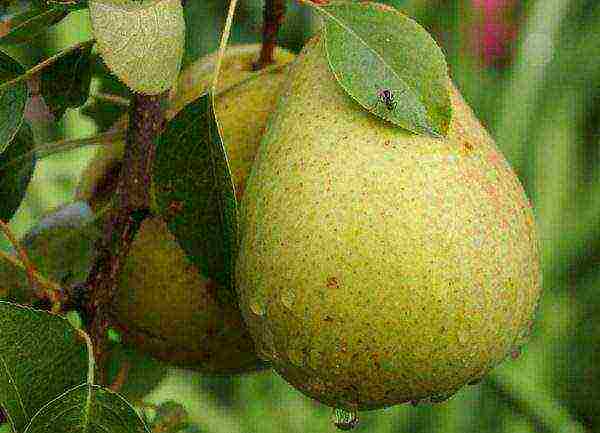 Pear Bessemyanka belongs to high-yielding varieties
Pear Bessemyanka belongs to high-yielding varieties
Popular and quite interesting for planting, especially spread in the Central regions, it also grows well in the middle lane. The tree is vigorous, growth rates are fast, yields stable, does not need rest. The yield is high, more than 50 kg of fruits are harvested per year. The tree is more than 6 m high, with spreading and curved branches. The leaves are oval, dark green in color, with rounded edges. The variety is also resistant to frost, but prone to scab and other diseases.
Annually it pleases with a large amount of harvest, although the fruits are rather small, more like apples. Light green in color, firm when ripe, the fruits turn yellow and soft when ripe. Attached to branches, one fruit on short stalks. Ripening occurs at the end of summer, when the fruits become yellowish.... Does not last long on the tree, quickly falls off. In addition, it does not lie for long and in a torn form, no more than 2-3 weeks.
In Europe, until the moment when tobacco was introduced, crushed pear leaves were used for smoking.
Skorospelka from Michurinsk
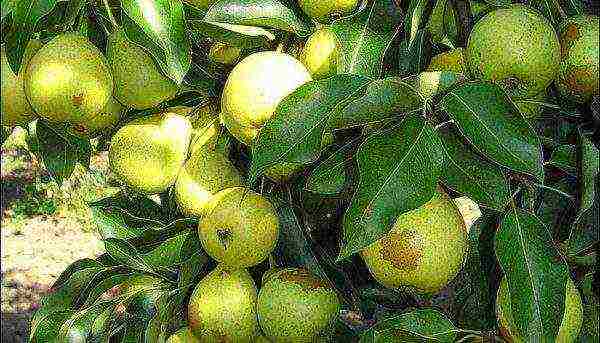 Pear Skorospelka from Michurinsk
Pear Skorospelka from Michurinsk
This variety breaks all records for the speed of fruit ripening. Bred by IV Michurin, as a result of crossing the varieties Citron de Carme and Bere Ligel. It belongs to the early varieties of pear, the harvest ripens by the middle of summer... It is a tall tree, the shape of the trunk is pyramidal, light brown in color.
Fruits no more than 90 grams, green in summer, acquire a yellow tint when fully ripe. Small fruits are offset by taste: sweet, juicy, this pear is loved not only by gardeners, but bees and birds. Therefore, it is better to collect them when they are a little hard, they are stored for no more than a week. The tree itself is winter-hardy, with a dense crown, resistant to diseases and pests.
Allegro
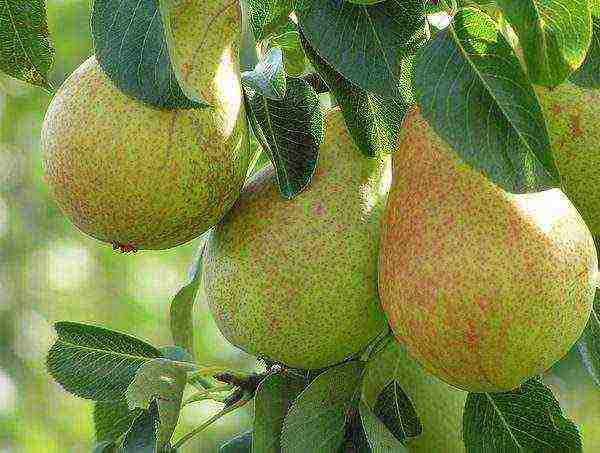 Pear variety for the middle Allegro strip
Pear variety for the middle Allegro strip
Bred thanks to artificial pollination of the Osennyaya Yakovleva variety.Another variety for the middle lane, which bears fruit annually, is unpretentious in care, resistant to disease and severe cold. Fruiting begins at the age of 3 years, over time, the fruits become larger in size. Medium-sized tree, more than 5 m high, with a lowered crown. The branches are curved, light gray in color, the leaves are slightly elongated, closely green in color.
A pear weighing from 120 grams with a thick skin, but juicy and sweet pulp, with a spicy aroma. Correct pear-shaped, the fruits are slightly elongated. They are attached to the branches with a thick stalk, grow on a branch one by one. Ripening occurs at the beginning of August., the fruits turn yellowish-red and become soft. The variety is not stored for a long time, ripe fruits hang on the tree for no more than 2 weeks, but when assembled they can lie for more than a month.
The middle zone of Russia has a special climate that is not suitable for growing all varieties of pears. There are pronounced hot summers, severe winters, and transitional periods with a lot of precipitation. Only those who “love” this weather can grow and bear fruit here, and proper care will ensure a greater pear yield.
Garden varieties for the Moscow region, description
Prominent or Bumpy
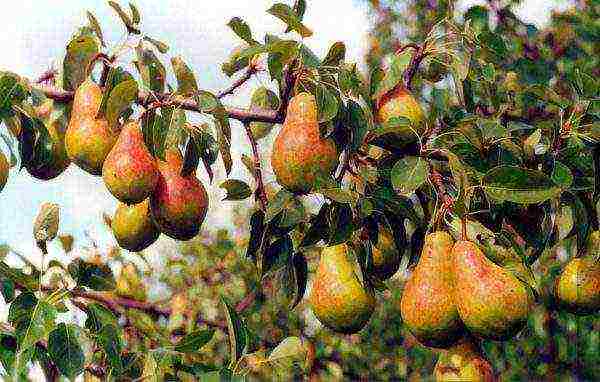 Pear variety Bumpy
Pear variety Bumpy
A pear variety that has long been loved by the Moscow region. A tree no more than 5 m high, with a fairly spreading young crown, which subsequently takes on a pyramidal shape. During the summer, the tree forms many young branches, which must be cut in the fall, otherwise the fruits will become smaller. The leaf plate is elongated, with light streaks, dark green in color. Blooms in early spring, many white inflorescences with a pleasant aroma.
Fruiting begins in the 5th year, fruits of medium size, regular pear-shaped. The color is greenish-yellow during the summer, with a red tint closer to autumn. Fruits with thick skin and coarse white flesh... Sweet and juicy on the palate, with a pleasant aroma. When harvested, they can last for several months, but it is recommended to harvest the fruits in mid-August, when the fruits are quite hard and slightly underripe.
Tenderness
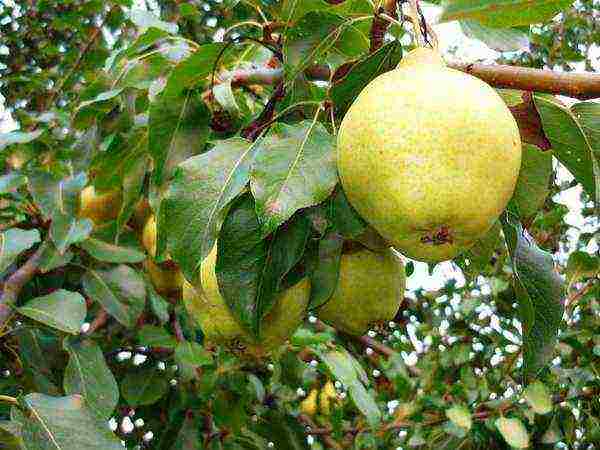 Hybrid variety Tenderness
Hybrid variety Tenderness
The variety obtained as a result of crossing Tyoma and Lyubimitsa Klapp. A particularly large amount of crops gives in the Volga region, the middle lane and in the Moscow region... The tree is medium-sized, no more than 4 m in height, with a sparse crown. The branches are thin, light gray. The tree blooms in mid-spring, white, small inflorescences. The leaves are round, with smooth edges, smooth. Frost-resistant, capable of bearing fruit annually. It prefers to grow in sunny areas, is resistant to diseases, is not afraid of pests, so growing this variety will not be difficult.
Fruits are large, weighing more than 200 grams with a regular pear-shaped fruit... The pear tastes soft, juicy, coarse-grained with a pleasant aroma. Attached to branches with short stalks. In the middle of the fruit is a chamber with brown seeds. The fruits of this pear are preserved for a long time both on the tree and in the harvested form, especially at a temperature of 0 degrees.
The pear tree is not capable of deforming, which is why, for example, rulers for architects are made from it.
Fabulous
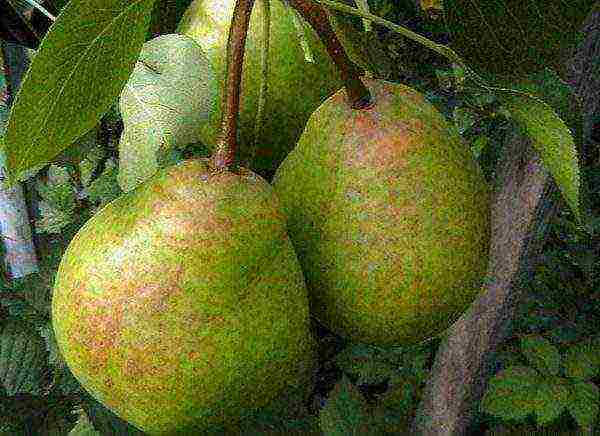 Pear Fairy is characterized as a tall and very productive variety.
Pear Fairy is characterized as a tall and very productive variety.
It got its name from the beautiful fruits. Obtained as a result of crossing the varieties Powislaya and Tenderness. The pear has a high yield, more than 30 kg of ripe fruits are harvested from one adult tree per season... The height of the tree reaches 4 m, the branches are dense, thin with a gray-brown crown. The leaf plate is smooth, rather small, of green shades, with small teeth along the edges.
When the pear ripens, it becomes yellow-reddish on one side and greenish on the other. Has the correct shape of the fruit, moreover one pear can weigh over 150 grams... The pulp of the pear is white, fleshy, medium-grained. In the center of the fruit are chambers with dark brown seeds. It tolerates diseases steadily, is not afraid of frost, seedlings easily take root in a new place.
Vera Yellow
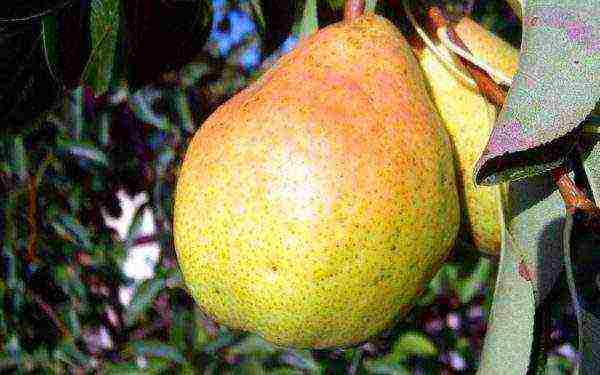 Vera Yellow
Vera Yellow
Another suitable variety for planting in the Moscow region. A tree with a height of more than 6 m, with a pyramidal trunk, with erect branches of a brown-brown color... Young leaves of light green tones, by autumn change color to dark green shades. Frost-resistant, does not need special care. The pear ripens in mid-September. It differs from others in that it has declines in yield, the fruits become smaller, but after a couple of years the pear again pleases with a large harvest.
Fruits have green hues throughout the summer, but change to yellow-orange colors closer to autumn. Fastens on short stalks, grows 2-3 pears in a bunch... To the taste, the pear is fragrant and fleshy, medium-grained pulp with a thin skin. Good storage capacity, especially in a cool place.
Elegant Efimova
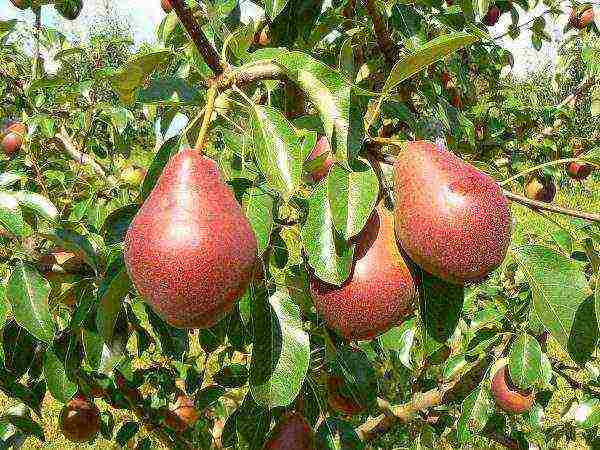 Variety Dressy Efimova
Variety Dressy Efimova
It turned out as a result of crossing the varieties Lyubimitsa Klappa and Tonkovotka. It grows well and gives a rich harvest in the Central Region, the Moscow Region and other nearby regions. High-yielding, winter-hardy, not subject to pests and diseases... The tree is tall, more than 5 m in height, with a dense crown, dark brown, pyramidal in shape. The leaves are small, dark green in color, with smooth edges.
Beautiful fruit appearance, red-orange tones are intertwined with green shades. But the fruits are small in size, weighing no more than 120 grams, regular, slightly distant shape. Soft, juicy pulp with a pleasant sweet aroma. The thin skin of the pear is prone to dark spots during the summer. Fruits ripen at the end of August, overripe quickly, so it is better to collect them a little hard, and it is recommended to store them in a cool and dark place.
Venus
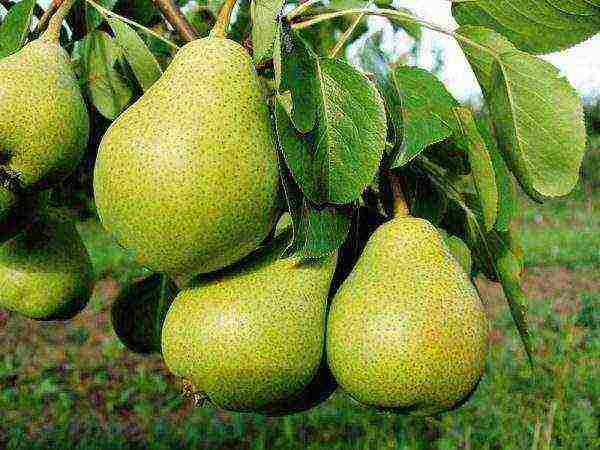 Pear venus
Pear venus
Another popular variety for planting, due to its winter hardiness and unpretentious care. Tree no more than 4m high, the crown is quite spreading, young branches are slightly lowered down, light brown in color. The variety blooms in early spring with white inflorescences with a sweet aroma. The variety also differs in high productivity, an adult tree is capable of producing more than 40 kg of harvest over the summer. Does not need rest, is able to bear fruit annually. In addition, the variety tolerates frosts, diseases and pests quite steadily.
The variety ripens in early autumn, the fruits are large, weighing up to 200 grams... Red-yellow in color, green tones when ripe. The taste is soft, juicy, slightly sour with a thin skin. They are stored for a long time both on the tree and when assembled.
Regardless of the specific variety, of which there are a huge variety today, the main thing in a pear is its taste and useful microelements, which are so abundant in ripe fruits. Winter, summer and autumn varieties differ from each other not only in taste, but also in the speed of fruit ripening., features of care, and the ability to preserve the fruit. Which variety to choose is up to you.
Do you want to feast on delicious, juicy, aromatic pears all year round? By planting trees of early, medium and late varieties on the site, you will provide yourself with ripe sweet pears for the entire summer season.
Surprisingly, very often, truly delicious pears are not very beautiful in appearance. Conversely, the fruits of most varieties, which look like they can be sent directly from the branches to the shelves, often do not differ in special taste. This article will help you understand the variety of tastes and forms.
August dew
High-yielding variety of summer ripening. Pear trees of this variety are considered undersized and even dwarf.They tolerate frost well down to –25 ° C and are resistant to diseases. The fruits ripen juicy, sweet with a slight sour accent and white, fine-grained, delicate taste pulp. Pears are harvested still green, but after ripening they acquire a green-yellow tint with a slight blush. Fruits that have reached maturity do not fall off.
|
Entering fruiting |
Tree height (m) |
Fruit weight (g) |
Harvest |
Shelf life (days) |
|
2-3 years |
2,5-3,5 |
Mid august |
10-14 |
|
Veles
Frost-resistant pear variety. The tree is medium-sized, with a spreading crown. Fruits are symmetrical with a smooth surface, greenish-yellow with an orange tint. The pulp is creamy, semi-oily, juicy, sweet and sour. These pears are great for fresh consumption.
|
Entering fruiting |
Tree height (m) |
Fruit weight (g) |
Harvest |
Shelf life (days) |
|
For 5-7 years |
3-4 |
140-200 |
Mid september |
60-70 |
Duchess Summer (Williams)
A high-yielding dessert variety of pears. Fruits are fragrant, juicy, sweet, classic pear-shaped, light green when picked, turn yellow during ripening. Suitable for drying and preserving. The pulp is white or creamy, juicy, wine-sweet with a nutmeg aroma. This variety also has disadvantages. Pear trees do not tolerate frost and drought well. Plants require pollinating neighbors, such as Forest Beauty or Lyubimitsa Klappa pears.
|
Entering fruiting |
Tree height (m) |
Fruit weight (g) |
Harvest |
Shelf life (days) |
|
For 5-6 years |
3-5 |
End of August |
45-50 |
|
Clapp's Favorite
Summer high-yielding pear variety. In the southern regions, yellow fruits with a reddish blush ripen at the end of July. The skin of the ripe fruit is smooth, the flesh is white, tender, juicy, aromatic, sweet with a sour taste. When ripe, the fruits quickly fall off and are not stored for long. It is a self-infertile variety, but in the vicinity of Duchess Letniy it will be able to fully “realize” its potential.
|
Entering fruiting |
Tree height (m) |
Fruit weight (g) |
Harvest |
Shelf life (days) |
|
7 year |
3-4 |
180-230 |
Early august |
10-15 |
Muscovite
A productive variety, perfect for growing in the middle lane. The trees are medium-sized, winter-hardy, but they are afraid of drought, due to which the yield decreases and pears fall. The fruits are wide, yellow-green in color, often with abundant rustiness. The pulp is white or creamy, coarse-grained, juicy, melting.
|
Entering fruiting |
Tree height (m) |
Fruit weight (g) |
Harvest |
Shelf life (days) |
|
For 6-7 years |
3-4 |
140-200 |
Mid september |
60-70 days |
Olivier de Serre
Winter variety of pears. The fruit looks like a flattened ball with tubercles. The view is not very presentable, but the taste is excellent. The flesh is sweet with a hint of almonds, very juicy, but quite dense. The fruits are ideal both for fresh consumption and for storage, transportation, conservation.
|
Entering fruiting |
Tree height (m) |
Fruit weight (g) |
Harvest |
Shelf life (days) |
|
For 6-7 years |
3-4 |
Early October |
140-160 |
|
Simply Maria
High-yielding winter-hardy pear variety. The tree is medium-sized. The fruits are pear-shaped, green-yellow in color with a slight pink blush. The skin is thin and dry, the flesh is yellowish-white, oily, fine-grained, sweet and sour with a weak aroma, very tasty. The variety is resistant to a complex of diseases.
| Entering fruiting | Tree height (m) | Fruit weight (g) | Harvest | Shelf life (days) |
| 3 year | 2-3 | 200 | October | 90-100 |
Every gardener dreams of growing a good harvest of delicious pears on his site. Using the information from our article, it will not be so difficult to do this.
Pear is a very juicy and aromatic fruit that has delighted the inhabitants of the planet for many thousands of years. But on the territory of the Moscow region, culture is not so widespread. The whimsicality and thermophilicity of the tree are to blame for everything.One good thing is that scientists have developed a wide variety of sweet and large varieties of this amazing fruit, which grow without problems in the regions of the middle lane. In the article we will tell you about the best pear varieties for the Moscow region, we will give their detailed description.
Features of crop cultivation in the Moscow region
- This region is located in the middle zone, therefore, it is characterized by a hot summer and cold winter, and between them there are rather humid springs and autumn. Due to the abundant rainfall, additional watering is practically not required;
- this fruit tree is quite thermophilic, and also has a different degree of frost resistance in case of transplantation, depending on the species. That is why the choice of the variety of this fruit for the Moscow region is the most important aspect. After all, not all varieties of pears can boast of the necessary characteristics for excellent performance, as well as long-term growth in this area;
- in the territory of the region, there are sharp changes in temperature. It is difficult enough to grow most of the crop species in these unfavorable weather conditions. Breeders came to the rescue, who bred a number of varieties specifically designed for this climatic zone.
Tip # 1. Planting seedlings should be carried out exclusively in the southwestern or southern part of the garden, due to the increased thermophilicity of the pear tree.
Pear care in the suburbs
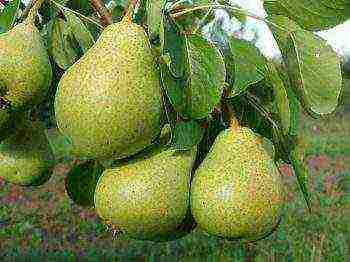
It is recommended to plant trees in areas located in lowlands where rainfall accumulates, as well as ground springs are located nearby.
These fruit trees need to be cared for:
- in winter, the root system of young pear trees should be covered for insulation;
- regularly remove weeds on the near-stem circles of young crops;
- it is also advisable to sow green manures, for example lupines, in the garden; after plowing them, the soil will be enriched;
- it is better to organize the irrigation system according to the type of sprinkling, in which case the water falls onto the tree through a rotating or standing sprayer, which has a large number of tiny holes, all this in the compartment recreates a real rain;
- immediately after irrigation, the soil should be well loosened, so the roots will be enriched with oxygen;
- it is recommended to fertilize the soil in the second year of growth of the fruit tree. Usually, top dressing is applied in the spring or autumn period, however, it is permissible to carry out top dressing throughout the summer. Read also the article: → “When to plant a pear. Planting pears in spring and autumn are the secrets of success. "
Tip # 2. It is not recommended to place "unripe" manure in the hole during planting, as it slowly disintegrates, and this is fraught with damage to the plant root.
Groundbait to increase pear yield
The main fertilizers used in the process of growing fruit in the Moscow region:
| Name | Description | Mode of application |
| Urea | Powder consisting of small crystals, which has a granular form, 45-46% of the composition is nitrogen. | This is one of the best nitrogen fertilizers available. It slightly acidifies the soil. It is necessary to use the drug in the spring during the cultivation of the land. It is used for liquid, dry and foliar dressing. |
| Superphosphate | This remedy comes in two varieties. Powdered fertilizer consists of 14-19.5% phosphorus, and granular contains 20-22%. | This substance is recommended to be used since autumn, since phosphorus is an inactive element, it is not readily soluble in water. To get to the root system from the moment of application, it needs a long period of time. |
| Potassium nitrate. | This product is a nitrogen-potassium fertilizer. | It is used as root and foliar dressing (1-2% solution), used for spraying along with pesticides and stimulants. |
| Kemira | The fertilizer does not contain chlorine, it contains the following microelements: Mg, S, B, Cu, Fe, Mn, Mo, Zn, Se | Affects root formation, tuber formation, stimulating their growth. The drug is applied to the soil in spring, summer and autumn. |
| Eco Plant | This mineral fertilizer is universal. A means of long-term action, it contains plant components and a lot of microelements: Mg 6-12%, Ca-9-17%, S 8-16%, including Fe, B, Zn, Cu, Mn, Cr, Mo, Co. | The drug reduces the amount of nitrates in fruits, prevents the accumulation of radionuclides, improves the synthesis of vitamins, saturates with useful minerals, and increases the resistance of crops to unfavorable conditions. Read also the article: → "Top dressing of trees in spring". |
★ Rating of popular pear varieties
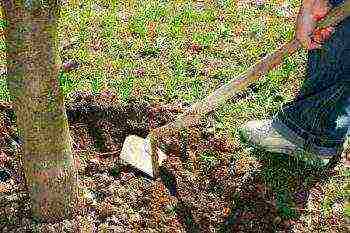
Autumn feeding of pears with humus and peat
Popular early ripening varieties
- "Lada" is a very common and demanded type. Pears ripen somewhere around mid-summer. This variety is not the finest or most pampered. The tree is able to bear fruit well even in a rather cloudy season. The period of onset of fruiting begins at the age of three;
- "Chizhevskaya" - this variety is characterized by its strength. The main advantage of the species is that the fruits do not fall from the tree, and also do not overripe. Harvesting of a fairly stable harvest begins in the middle or end of August;
- "Skorospelku from Michurinsk" - the variety ripens early, in mid-July, and sometimes at the end. These fruit trees have a very neat appearance, they do not take up much space in the garden. Ripe pears are yellow in color;
- "Rogneda" - this pear variety ripens at the end of the summer season, perhaps even at the beginning of autumn. After harvesting, the fruits should lie down for a while for final ripening. It is usually used in the course of various harvesting for the winter.
Popular mid-season varieties
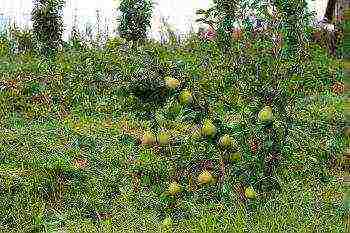
The area where the fruit grows must be protected from cold drafts.
Due to the difficult climatic conditions in the autumn in the middle lane, it is not recommended to plant these varieties.... Among all the varieties available, it is possible to single out the 2 most suitable, as well as fairly early mid-season varieties.
- "Bere Moskovskaya" - the fruits ripen in mid-September;
- "Otradnenskaya" - the beginning of the harvest at the end of the month of September. This pear is ideal for blanks.
Self-pollinating, self-fertile crop varieties
Self-fertility of plants enables them to be sufficiently independent of the influence of climatic conditions to achieve an uninterrupted harvest. Self-fertile varieties of fruit take root remarkably in regions with not very favorable weather norms during the flowering period of trees: the absence of bees, heavy rainfall, wind and cold.
The table shows common self-fertile pear varieties.
| Name | Short description |
| "Chizhevskaya" | It is a high-yielding species. It belongs to late-ripening varieties, characterized by high resistance to frost, as well as to a number of diseases. The fruit has a yellowish color, one half has a pink tint. Good taste - sweet with a slight sourness. The pulp is friable in texture, yellow-white in color. |
| "Tenderness" | It is considered one of the best late pears. The fruits are perfectly preserved even at 0 degrees. Large in size, weighing over 200 grams. The variety has stable yields. |
| "Rogneda" | This type is characterized by the following features: frost resistance; high resistance to the main types of diseases; the rapid onset of fertility after three years; unusual taste with a nutmeg undertone; good productivity; fruits look good and can be stored for almost 2 months in a relatively cold place. |
The best pear varieties according to production data
The Moscow region is located in the middle latitudes, it is dominated by a rather sultry summer, as well as a harsh winter period. In conditions of such climatic features, not all varieties of pears grow. However, there are species that are quite adapted to local weather conditions. Popular high-yielding fruit varieties will be described below.
| Variety name | Brief description: resistance to diseases, frost, storage capacity |
| "Lada" | This species belongs to the early summer, adapted to the harsh winter, as well as to the hot summer, while not reducing its yield. High disease resistance. The fruit is yellowish in color with a nice barrel. Sweet and sour to taste, they have a persistent aroma. The yield of this variety is consistently high. |
| "Chizhevskaya" | It is considered a representative of late-ripening species, easily tolerates frosts and hot summers. The variety is not susceptible to various fungal diseases. The fruit has a pinkish tint. It is characterized by high performance. |
| "Fabulous" | Quite a tall type of pear with large fruits, weighing more than 250 grams. The fruit is characterized by a green color with a reddish barrel. Good taste. The level of preservation is high, capable of withstanding transportation. The species is distinguished by its winter hardiness, as well as immunity to the gall mite. |
Answers to frequently asked questions
Pear variety Lada. The yield of different varieties of pears is different. This should be borne in mind when choosing a variety.
Question number 1... How to properly prepare a fruit tree for wintering?
First, rotten fruits are removed from the plant and under it. Then the trunk and crown are treated with a 5% urea solution to prevent the development of scab. Do not forget about the prevention of pests and diseases. After that, we carefully insulate the plant.
Question number 2. What sort of pear is the best for the Moscow region?
There are a lot of options. Some of the best varieties are: Lada, Rogneda, Tenderness, etc. When choosing, it is necessary to take into account a number of factors. This tree is very thermophilic and at the same time not particularly winter hardy. That is why the choice of a species suitable for a given area should be taken very carefully.
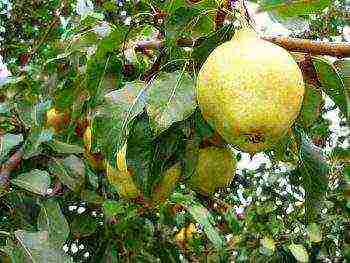
Pear Tenderness - a high-yielding winter-hardy variety
Question number 3. Can this crop be pruned in summer?
It is not advisable to carry out the procedure for pruning a pear tree in the summer. Since at this time there is an accumulation of glucose, as well as other useful substances. Moreover, in the process of pruning, young leaves are destroyed, this leads to a loss of nutrients. It is more rational to wait for the autumn season. Read also the article: → "Pruning pears: step-by-step instructions, schemes, terms".
Question number 4. How does the choice of a crop variety affect its yield?
To begin with, each variety has its own characteristics and performance indicators, including the level of yield. Based on the variety of types of pears available today, everyone can choose the fruit to their liking.
Gardeners' mistakes during cultivation
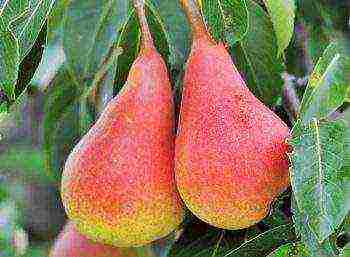
A high yield can be harvested in any climatic zone, subject to the correct selection of fruit varieties, as well as taking into account the necessary standards of cultivation.
- The most basic mistake lies in the initially incorrectly selected pear variety. That is, it is not intended for cultivation in the climatic zone of the Moscow region.
- Violations of the elementary care of the crop are also possible, as a result, a poor harvest, or even the death of the plant.
- When choosing which pear variety is best suited for planting in the country, gardeners often forget that many of them may need pear pollinator varieties.
Finally, I would like to note that the Moscow region region is located in such a climatic zone, which, in turn, is characterized by a number of features. Unfortunately, they are not suitable for every variety of pears.Therefore, before purchasing young trees of a certain type, you should carefully read whether the weather conditions in this area are optimal for its growth.
🎥 Video lesson from Bogdan Ribak "Review of the super variety Talgar beauty"
Amateur gardener Bogdan Ribak shares his experience and talks about one of the best pear varieties "Talgar beauty" ⇓.
Rate the quality of the article. We want to be better for you:


